Table of Contents
- Introduction
- Editor’s Choice
- Health Insurance Coverage Statistics – Market
- Total Population Covered – Health Insurance Coverage Statistics
- Private Health Insurance Statistics
- Public Health Insurance Coverage Statistics
- Health Insurance Coverage by Age Groups
- Health Insurance Coverage Statistics by Gender
- State-Wise Health Insurance Coverage
- Income and Socioeconomic Factors in Health Insurance Coverage
- Employer-Sponsored – Health Insurance Coverage Statistics
- Health Insurance Coverage Statistics – Access to Care
- Public Health Insurance Programs
- Recent Developments
- Key Takeaways
- FAQs
Introduction
Health Insurance Coverage Statistics: Health insurance coverage refers to the extent to which individuals or groups are protected by an insurance policy that provides financial support to cover the costs of medical expenses and healthcare services.
It is a contractual agreement between the insured (the policyholder) and the insurance company, wherein the insured pays regular premiums in exchange for the promise of financial protection in the event of illness, injury, or other covered medical conditions.
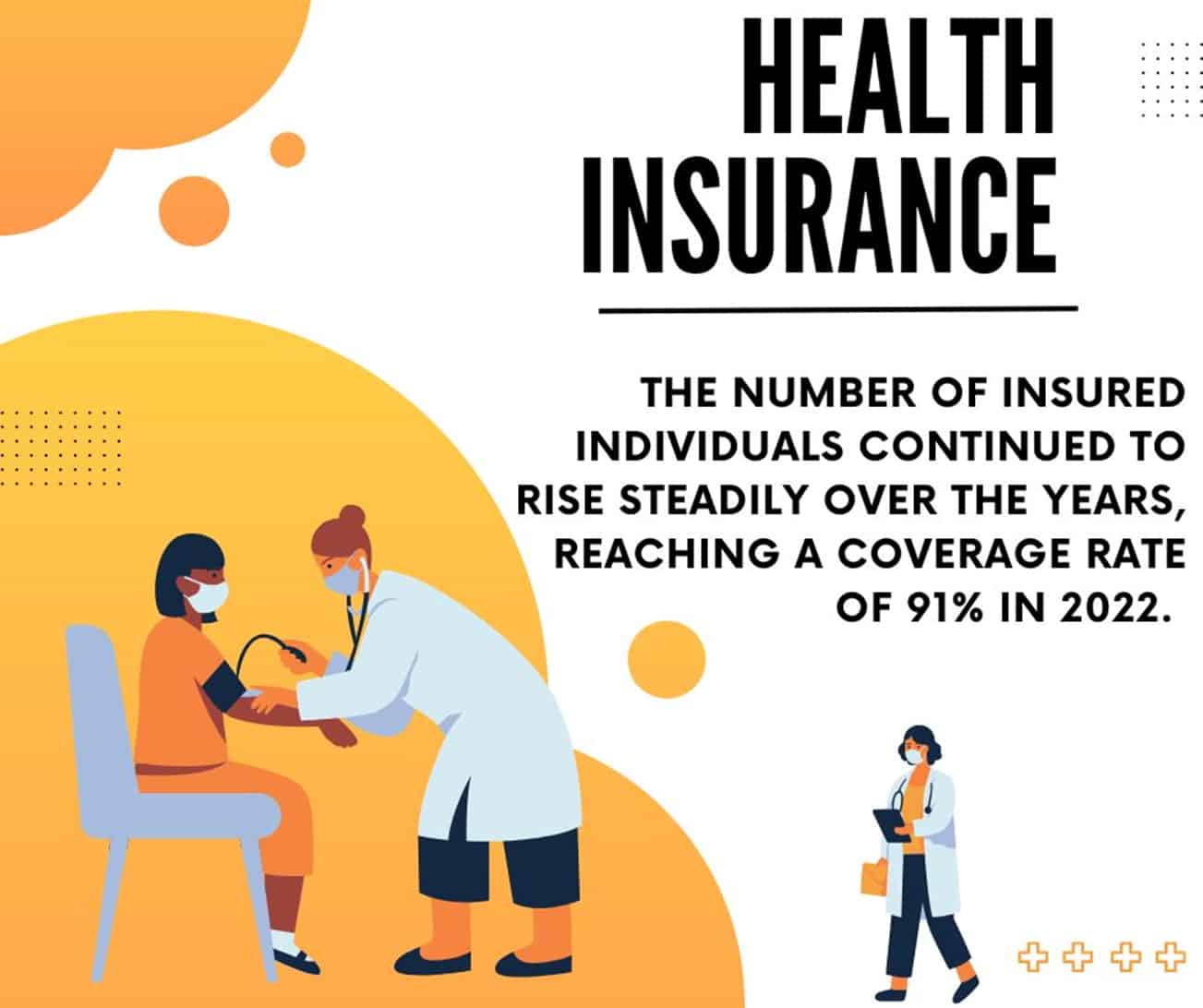
Editor’s Choice
- The global Health Insurance Market was valued at USD 2.3 Trillion in 2023 and is further projected to register substantial growth of USD 4.7 Trillion by 2033, with a 7.5% CAGR.
- The uninsured rate in the United States declined to 8.8% in 2022.
- Approximately 56% of Americans receive health insurance coverage through their employer.
- Medicaid covers over 77 million low-income individuals and families in the U.S. as of 2021.
- The uninsured rate among adults aged 19-64 was 13.5% in 2022.
- In 2022, 91.2% of children under 19 years old had health insurance coverage.
- Medicare, the federal health insurance program for individuals aged 65 and older, covers approximately 63 million beneficiaries.
- Texas had the highest uninsured rate among states in 2022, with 17.7% of its population lacking health insurance coverage.
- The Affordable Care Act (ACA) reduced the uninsured rate for non-elderly adults from 20.4% in 2010 to 12.4% in 2018.
(Source: U.S. Census Bureau, Kaiser Family Foundation, Medicaid.gov, Centers for Disease Control and Prevention, U.S. Census Bureau, Medicare.gov, Commonwealth Fund)
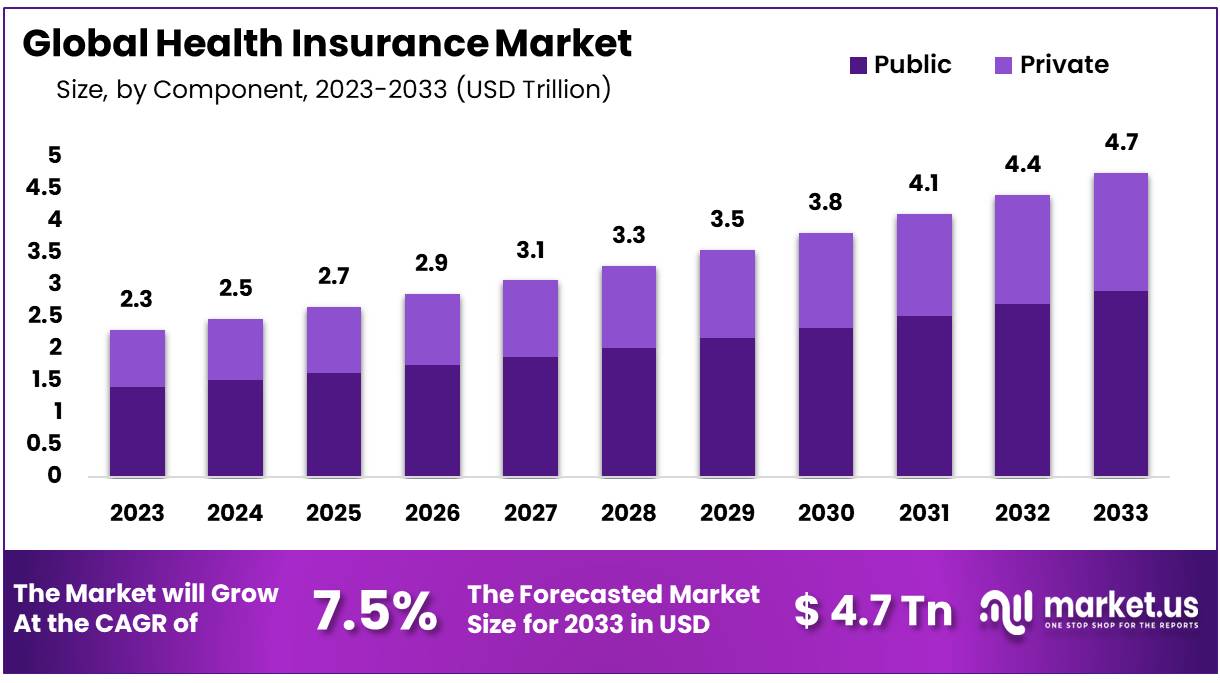
Health Insurance Coverage Statistics – Market
- The global Health Insurance market size is expected to be worth around US$ 5,518.60Bn by 2031 from US$ 3,587.80Bn in 2021, growing at a CAGR of 4.39% during the forecast period from 2021 to 2031.
- In 2022, the largest market share for health insurance was held by North America, accounting for over 40% of the global market.
- The Asia-Pacific region is expected to witness the highest growth rate in the health insurance market during the forecast period.
- Private health insurance policies dominate the market, covering more than 50% of the insured population worldwide.
- Employer-sponsored health insurance remains a significant source of coverage for individuals, with over 50% of the non-elderly population being covered through their employer’s plans.
- Government-funded health insurance programs, such as Medicaid and Medicare, play a crucial role in providing coverage to vulnerable populations, accounting for nearly 25% of total health insurance enrollment in the United States.
- Generative AI in Health Insurance Market size is expected to be worth around USD 572.9 Mn by 2032 from USD 35.0 Mn in 2022, growing at a CAGR of 33.2% during the forecast period from 2023 to 2032.
(Source: marketresearch.biz, World Health Organization, Kaiser Family Foundation, National Center for Biotechnology Information)
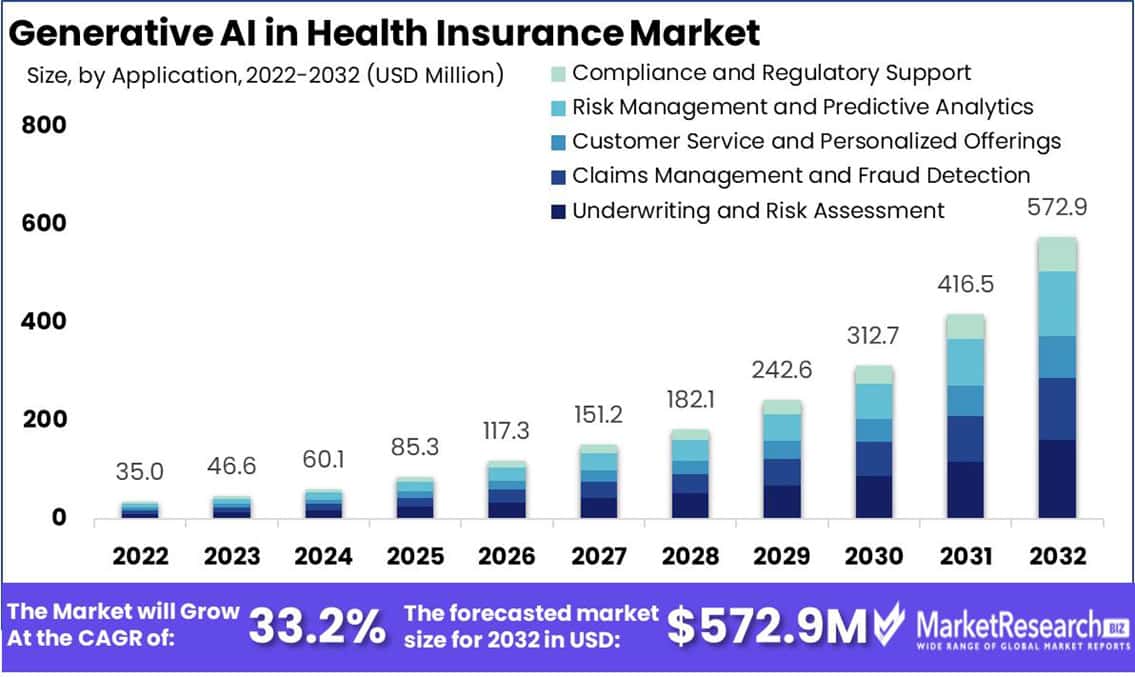
Total Population Covered – Health Insurance Coverage Statistics
- In 2020, approximately 91% of the U.S. population had health insurance coverage.
- The number of insured individuals continued to rise steadily over the years, reaching a coverage rate of 91% in 2020.
- The uninsured rate has seen a decline in recent years, from 16% in 2010 to 9% in 2020.
- Government-sponsored programs, such as Medicaid and Medicare, played a significant role in providing coverage, with over 39% of the population relying on these programs in 2020.
- Employer-sponsored health insurance remained a common source of coverage, with approximately 55% of the population obtaining insurance through their employer in 2020.
(Source: U.S. Census Bureau)

Private Health Insurance Statistics
- In 2020, approximately 91% of the U.S. population had health insurance coverage.
- The number of insured individuals continued to rise steadily over the years, reaching a coverage rate of 91% in 2020.
- The uninsured rate has seen a decline in recent years, from 16% in 2010 to 9% in 2020.
- Government-sponsored programs, such as Medicaid and Medicare, played a significant role in providing coverage, with over 39% of the population relying on these programs in 2020.
- Employer-sponsored health insurance remained a common source of coverage, with approximately 55% of the population obtaining insurance through their employer in 2020.
- Approximately 47 million people in the United States remained uninsured in 2021, and the lack of affordable private health insurance options was cited as one of the reasons for not having coverage.
(Source: U.S. Census Bureau)
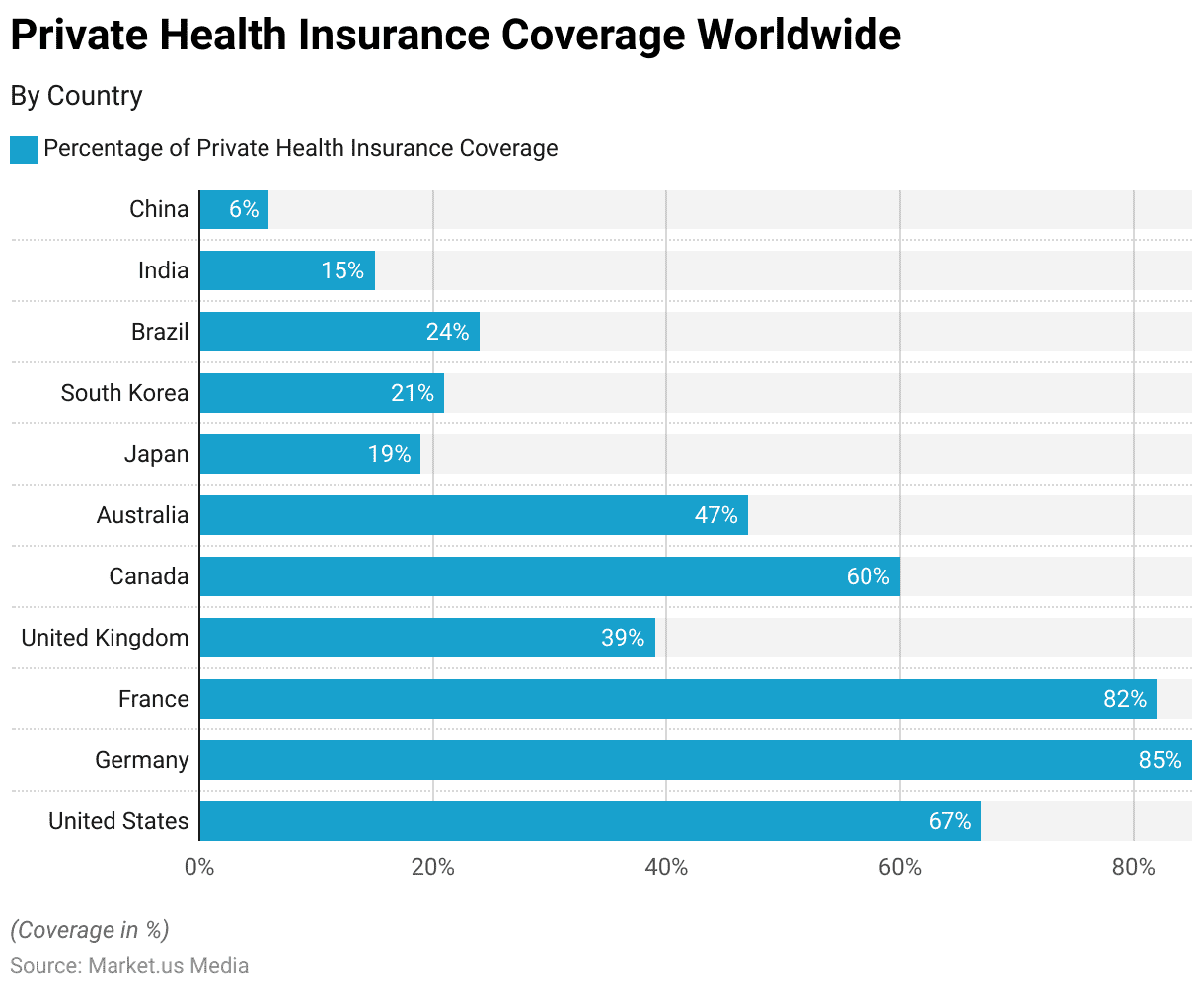
Private Health Insurance Coverage Among People Under Age 65
- Among people under age 65, 65.4% (176.1 million) had private health insurance coverage at the time of the interview.
- This private health insurance coverage includes 56.9% with employment-based coverage, 7.2% with directly purchased coverage, and 1.3% from other sources (Figure 2, Table 2).
- For children, 55.1% had private health insurance, with 50.3% having employment-based coverage and 4.0% having directly purchased coverage.
- Working-age adults had a higher private health insurance coverage rate at 69.2%, with 59.3% having employment-based coverage and 8.3% having directly purchased coverage.
- Working-age adults were more likely than children to have private insurance overall and through an employer or direct purchase.
(Source: CDC)
Take advantage of our unbeatable offer - buy now!

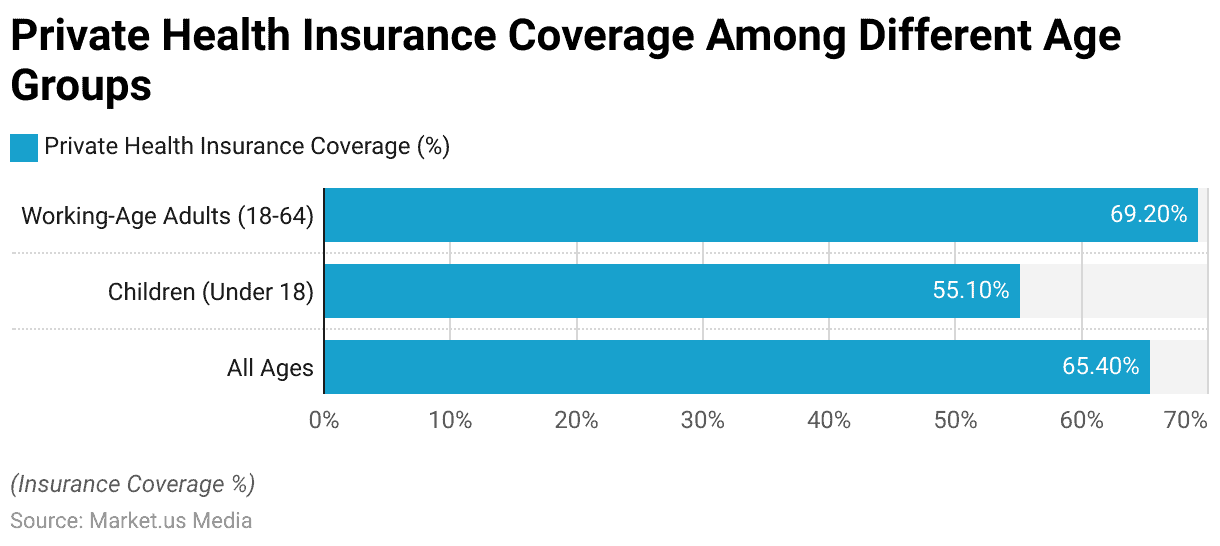
Public Health Insurance Coverage Statistics
- In the United States, as of 2021, approximately 20% of the population relies on public health insurance programs such as Medicaid and Medicare.
- Medicaid, a federal-state program, covers over 70 million low-income Americans, making it the largest public health insurance program in the country.
- Medicare, a federal program primarily for seniors aged 65 and older, covers around 63 million Americans.
- The Affordable Care Act (ACA) expanded Medicaid eligibility in several states, resulting in increased coverage for low-income adults. As of 2021, 39 states and Washington D.C. have expanded Medicaid.
- Medicaid and CHIP (Children’s Health Insurance Program) together provide health coverage for nearly 40% of children in the U.S.
- Public health insurance programs play a crucial role in reducing the uninsured rate. In 2019, the uninsured rate among non-elderly adults was 14.8% without Medicaid expansion, but it was significantly lower at 9.2% in states that expanded Medicaid.
- Medicaid spending accounted for about 9.7% of the total national health expenditure in 2019.
- Medicare spending accounted for around 15% of the federal budget in 2021.
(Source: Kaiser Family Foundation, Medicaid.gov, CMS.gov, Urban Institute, The Balance)
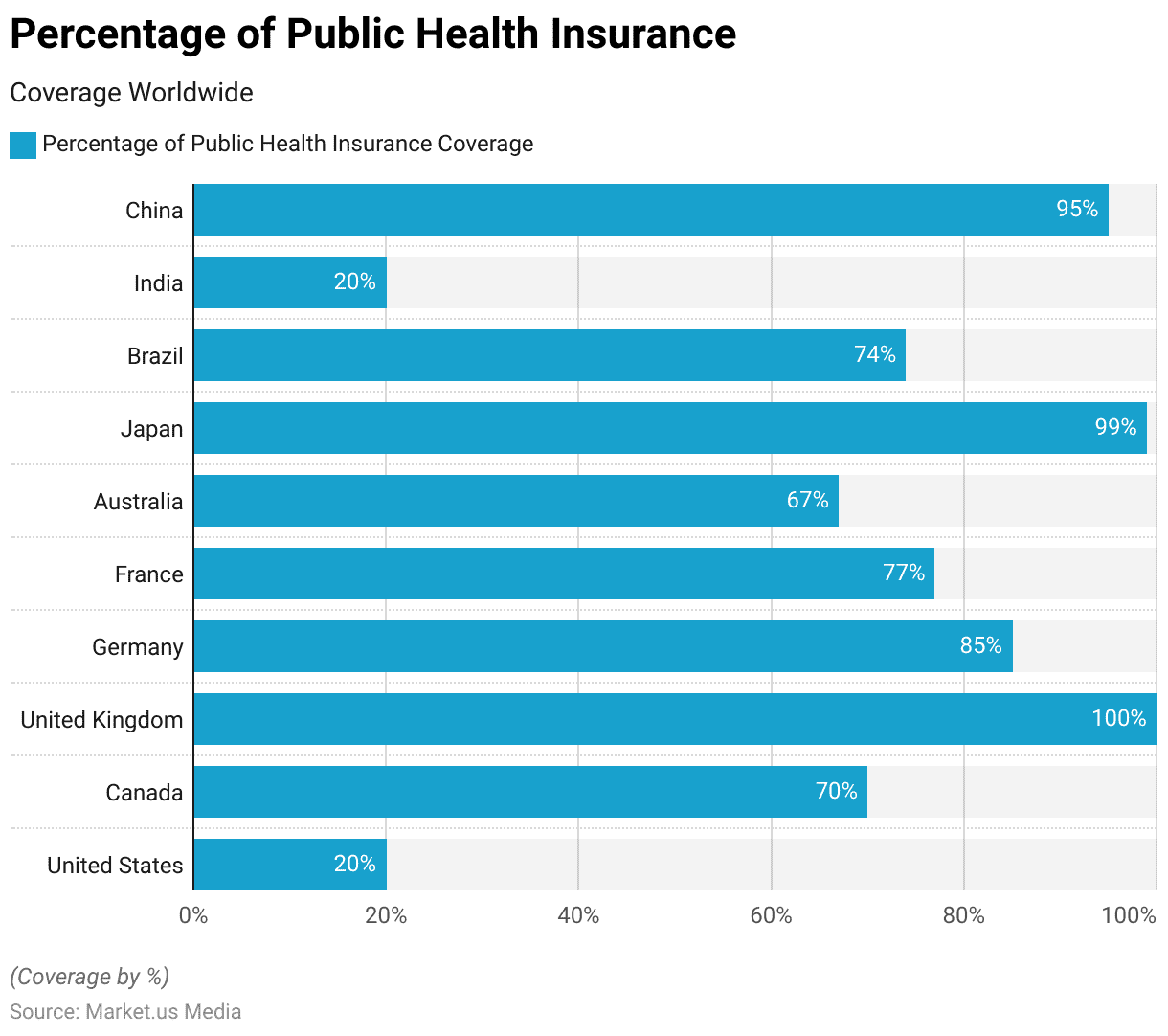
Public Health Insurance Coverage Among People Under Age 65
- Among people under the age of 65, 26.5% (approximately 71.3 million individuals) had public health insurance coverage at the time of the interview.
- Within this group, 21.4% were covered by Medicaid and CHIP (Children’s Health Insurance Program), which is the largest public health insurance program in the United States.
- Approximately 3.2% of individuals under 65 were covered by military health insurance.
- Around 2.9% of people under 65 had coverage through Medicare, which is primarily for individuals aged 65 and older.
- Focusing on children specifically, 42.9% had public health insurance coverage.
- Among children with public coverage, 39.7% were covered by Medicaid and CHIP, which provides health coverage to low-income children and families.
- A smaller percentage, 2.8%, had health insurance through military coverage.
- A very small percentage, 0.4%, of children had coverage through Medicare.
- Among working-age adults (those under 65), 20.4% had public health insurance coverage.
- Within this group, 14.6% were covered by Medicaid and CHIP.
- Approximately 3.8% of working-age adults had Medicare coverage.
- About 3.3% of working-age adults were covered by military health insurance.
- Children were more likely to have Medicaid and CHIP coverage compared to working-age adults.
- On the other hand, children were less likely to have Medicare coverage than working-age adults.
(Source: CDC)
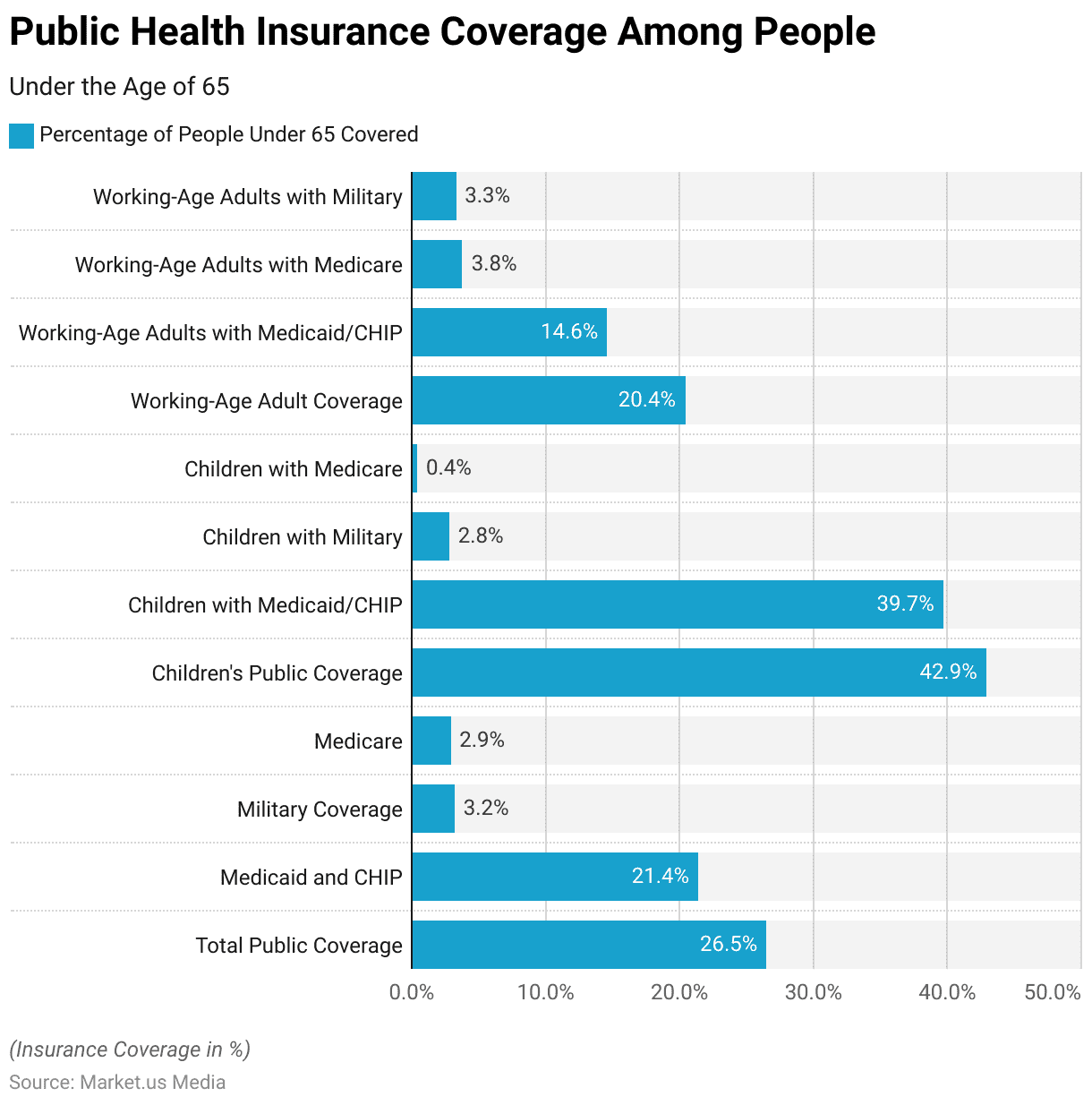
Health Insurance Coverage by Age Groups
- In the age group of 18-24 years, approximately 65.2% of the population has health insurance coverage, while around 34.8% of individuals in this age bracket remain uninsured.
- Among individuals aged 25-34 years, approximately 72.6% of the population has health insurance coverage, leaving around 27.4% of individuals in this age group without insurance.
- For those in the age group of 35-44 years, approximately 78.9% of the population is covered by health insurance, with around 21.1% of individuals remaining uninsured.
- In the age group of 45-54 years, approximately 83.2% of the population has health insurance coverage, while about 16.8% of individuals in this age range are uninsured.
- Among individuals aged 55-64 years, approximately 89.5% of the population has health insurance coverage, with only about 10.5% of individuals in this age group lacking insurance.
- For individuals aged 65 years and older, who are eligible for Medicare, approximately 99.0% of the population has health insurance coverage, leaving only about 1.0% of individuals in this age group without insurance.
(Source: Centers for Medicare & Medicaid Services, 2022)

Health Insurance Coverage Rates Among Different Racial and Ethnic Groups
- Asian Americans have the highest health insurance coverage rate among racial and ethnic groups, with approximately 92% of the population having health insurance.
- Non-Hispanic White Americans also show a high coverage rate, with around 89% of the population having health insurance.
- African Americans have a coverage rate of approximately 87%, indicating a smaller but still substantial proportion with health insurance.
- Hispanic Americans, while showing improvement, still have a lower coverage rate compared to other groups, with about 78% of the population having health insurance.
- Native Americans and Alaska Natives have a coverage rate of around 75%, indicating disparities in access to health insurance among these groups.
- Disparities in health insurance coverage rates persist, with higher uninsured rates among minority groups compared to non-Hispanic Whites.
(Source: Kaiser Family Foundation, U.S. Census Bureau, Centers for Disease Control and Prevention, Health Insurance Coverage, Indian Health Service, American Journal of Public Health)

Health Insurance Coverage Statistics by Gender
- Women are more likely to have health insurance coverage compared to men.
- Approximately 90% of women have health insurance, while only 85% of men have coverage.
- The uninsured rate among women has decreased by 5% over the past five years, while the rate for men has decreased by 3%.
- Women are more likely to have employer-sponsored health insurance than men.
- Among those with employer-sponsored plans, women have a higher likelihood of being enrolled in more comprehensive coverage options.
(Source: Health Insurance Coverage Survey)
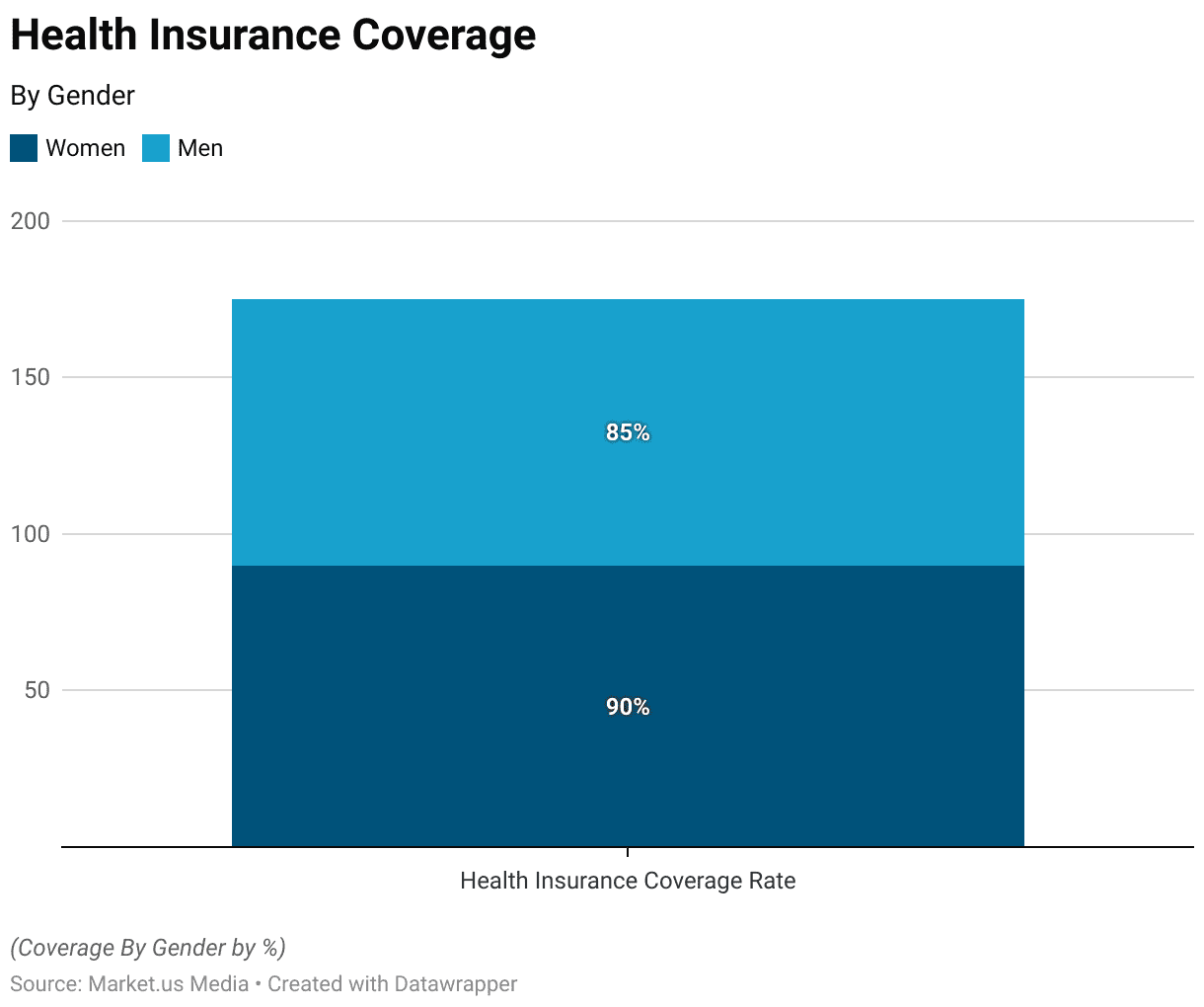
State-Wise Health Insurance Coverage
- The health insurance coverage rate in the United States is 91.4%.
- Germany boasts a high health insurance coverage rate of 99.7%.
- Japan’s health insurance coverage rate stands at an impressive 99.0%.
- The health insurance coverage rate in France is 98.8%.
- In the United Kingdom, the health insurance coverage rate is reported to be 89.9%.
- Canada’s health insurance coverage rate is 98.1%.
- Australia has a health insurance coverage rate of 91.0%.
- Switzerland’s health insurance coverage rate is notably high at 99.5%.
- The health insurance coverage rate in the Netherlands is 99.0%.
- Sweden’s health insurance coverage rate is 97.5%.

Income and Socioeconomic Factors in Health Insurance Coverage
- The uninsured rate is higher among low-income individuals, with 19.2% of those with incomes below the poverty level lacking health insurance.
- In contrast, only 4.8% of individuals with incomes at or above 400% of the federal poverty level were uninsured.
- Minority populations experience higher rates of uninsurance due to socioeconomic disparities, with 12.7% of Hispanics and 11.5% of Blacks being uninsured compared to 5.7% of non-Hispanic Whites.
- Individuals living in states that did not expand Medicaid under the Affordable Care Act (ACA) are more likely to be uninsured.
- Young adults aged 18 to 34 have a higher uninsured rate at 15.5%, reflecting challenges in accessing employer-sponsored coverage and the perception of lower healthcare needs among this group.
- Uninsured rates are significantly lower among those with college degrees (5.1%) compared to those with only a high school education (12.3%).
- The uninsured rate for non-citizens is much higher at 23.7% compared to 5.8% for native-born citizens.
(Source: U.S. Census Bureau, Kaiser Family Foundation)
Employer-Sponsored – Health Insurance Coverage Statistics
- In 2023, approximately 56% of workers in the United States were covered by employer-sponsored health insurance.
- The average annual premium for employer-sponsored family coverage was $15,000 in 2023.
- On average, employees contributed about $5,000 towards the annual premium for family coverage.
- The average annual deductible for single coverage was $1,650 in 2023.
- The average annual deductible for family coverage was $3,700 in 2023.
- The average copayment for primary care office visits was $25 in 2023.
- The average copayment for generic prescription drugs was $10 in 2023.
- The average copayment for primary care office visits was $25 in 2023.
- The average copayment for generic prescription drugs was $10 in 2023.
- About 26% of large employers offered financial incentives, such as premium reductions, for employees who participated in wellness programs in 2023.
- 85% of large employers offered telemedicine services as part of their health insurance benefits in 2023.
- The percentage of employers with a waiting period for new employees to be eligible for health benefits decreased to 24% in 2023.
- Only 47% of small businesses with fewer than 50 employees offered health benefits to their workers in 2023.
(Source: Employer Health Benefits Survey by Kaiser Family Foundation)

Health Insurance Coverage Statistics – Access to Care
- Individuals without health insurance are less likely to have a regular primary care provider, with around 45% reporting no usual source of medical care.
- Uninsured adults are less likely to receive necessary medical care, including preventive services, screenings, and treatments, compared to those with health insurance.
- In states that expanded Medicaid under the Affordable Care Act, the uninsured rate dropped significantly, with an average decrease of about 5.4 percentage points.
- Medicaid expansion has led to improved access to care, with approximately 68% of low-income adults gaining coverage in expansion states.
- Adults with health insurance coverage are more likely to have regular check-ups and seek medical attention when needed, contributing to better health outcomes.
- Lack of health insurance is associated with delayed medical care and higher rates of preventable hospitalizations.
- Access to affordable health insurance reduces the financial barriers to healthcare, leading to a decrease in the number of medical bankruptcies.
- Approximately 23% of uninsured adults reported avoiding needed medical care due to cost concerns, compared to only 5% of those with private insurance.
- The uninsured rate among non-elderly adults varies significantly by state, ranging from around 4% in Massachusetts to over 20% in Texas.
(Source: National Center for Health Statistics, Kaiser Family Foundation, Urban Institute, Kaiser Family Foundation, Centers for Disease Control and Prevention, National Institute for Health Care Management, American Journal of Public Health, Kaiser Family Foundation, Commonwealth Fund)
Public Health Insurance Programs
- Medicaid covers over 70 million low-income individuals in the United States, making it one of the largest public health insurance programs.
- Medicare provides health coverage to more than 60 million elderly and disabled individuals.
- The Children’s Health Insurance Program (CHIP) ensures millions of children in low-income families, with approximately 8.3 million enrolled beneficiaries.
- Medicaid expansion, under the Affordable Care Act (ACA), has extended coverage to millions of low-income adults in states that adopted the expansion.
- In 2020, Medicaid accounted for 16% of total national health expenditures, highlighting its significant role in the healthcare system.
- Medicare spending accounted for approximately 15% of total national health expenditures in 2020.
- Medicaid and CHIP together covered 39% of all children in the United States in 2019.
- Medicare Advantage plans an alternative to traditional Medicare, covered around 26 million beneficiaries in 2021.
- Medicaid spending on long-term services and supports (LTSS) for the elderly and people with disabilities totaled $191.6 billion in 2019.
- The Federal Medical Assistance Percentage (FMAP) determines the federal funding match rate for Medicaid, with rates varying by state’s per capita income.
(Source: Medicaid.gov, Centers for Medicare & Medicaid Services, Kaiser Family Foundation)
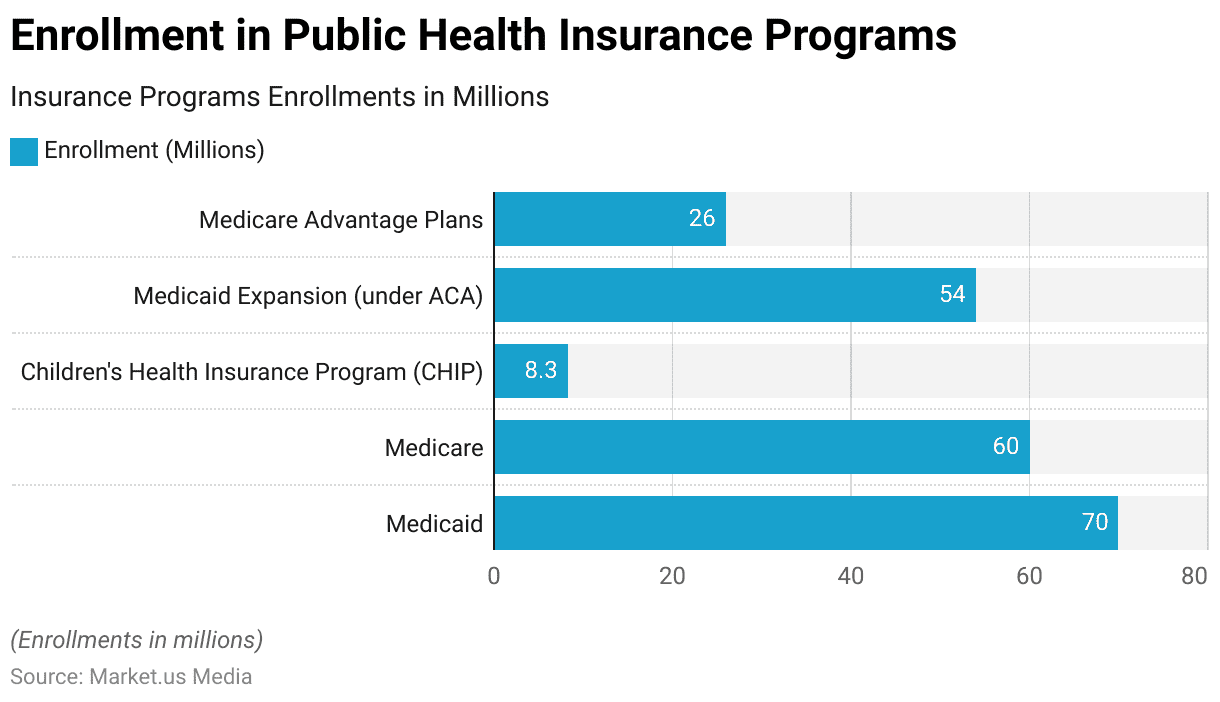
Recent Developments
Enrollment Trends:
- The Affordable Care Act (ACA) Health Insurance Marketplace saw a historic enrollment during the 2024 Open Enrollment Period, with 21.3 million people selecting plans.
- This figure includes over five million individuals new to the Marketplace and 16 million renewals, highlighting the ACA’s increasing significance in providing health coverage.
Technological Investments and InsurTech:
- The sector is witnessing substantial funding for new technology and innovation, particularly in InsurTech.
- Insurance technology companies (InsurTechs) are at the forefront of acquisition activity, as carriers seek to enhance their capabilities across the value chain through point solutions powered by these technologies.
Merger and Acquisition (M&A) Activity:
- While M&A activity in the insurance sector has seen a decline since Q2 2022 due to macroeconomic factors, there’s an anticipation of an uptick in deals as the economy stabilizes.
- This shift suggests a reinvigorated focus on strategic growth and consolidation within the industry.
Shifting Industry Focus:
- The insurance industry is increasingly pivoting towards a customer-centric business model and embracing its role as a sustainability ambassador.
- This transformation involves adopting advanced technologies and modifying company culture to minimize silos, enhance collaboration, and improve customer data accessibility.
- Such changes are fundamental for insurers to stay relevant and contribute positively to societal welfare.
Key Takeaways
Health Insurance Coverage Statistics – Health insurance coverage is a vital aspect of healthcare systems, offering financial protection and access to medical services for individuals and families.
By providing a safety net against unforeseen medical expenses, health insurance ensures that people can seek necessary treatment without facing significant financial burdens.
It plays a crucial role in improving overall population health and fostering a more equitable healthcare system.
With the right coverage, individuals can enjoy peace of mind and better opportunities to maintain their well-being, promoting a healthier and more productive society as a whole.
FAQs
Health insurance is a type of insurance policy that helps cover the costs of medical and healthcare expenses. It provides financial protection to individuals by paying for a portion of their medical bills, including doctor visits, hospital stays, prescription medications, and other eligible healthcare services.
– Employment status and access to employer-sponsored insurance.
– Income levels and affordability of insurance plans.
– Eligibility for government programs such as Medicaid or Medicare.
– Geographic location and availability of healthcare resources.
– Age, as younger populations may have lower coverage rates.
– Immigration status and citizenship.
– Policy changes and healthcare reforms.
Discuss your needs with our analyst
Please share your requirements with more details so our analyst can check if they can solve your problem(s)



